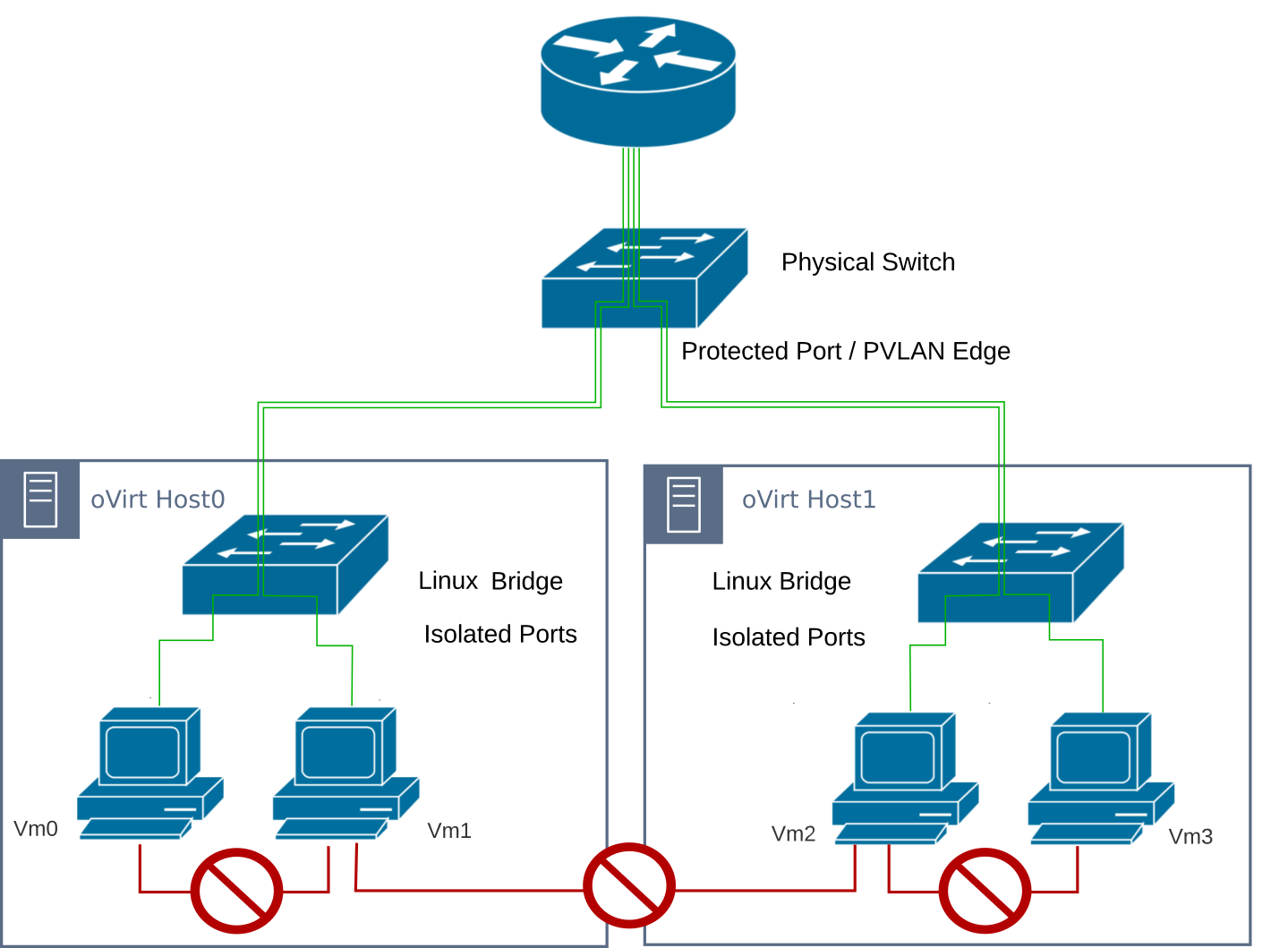Most of them are outdated, but provide historical design context.
They are not user documentation and should not be treated as such.
Documentation is available here.
Isolated ports
Summary
This feature enables you to prevent specific VMs on the same logical network from communicating with and seeing each other.
The state of the feature is tracked in [RFE] Private VLAN / port isolation . Related patches can be found on gerrit topic:isolated_port.
Owner
-
Name: Aleš Musil
-
Email: amusil@redhat.com
Detailed Description
There are scenarios in which multiple VMs that share an uplink should not be able to communicate with each other. For example when VMs are owned by multiple customers. The shared uplink might be a connection to the gateway to the outside network or the DHCP server.
In such scenarios, it is required to isolate the network connections of the VMs per port, because filtering on MAC addresses does not address all cases, e.g. Bug 1651499 and Bug 1651467.
Such scenarios can be addressed by creating a VLAN tagged logical network with a dedicated IP subnet per VM, but this is a waste of the limited VLANs and subnets as described by Cisco.
For this reason switches commonly provide isolation per port. There are two popular implementation levels of private VLAN:
-
The simple level prevents ports from communicating with each other by not forwarding any traffic to any other isolated port. This is called port isolation in Linux, private interfaces in FreeBSD, or PVLAN Edge (Protected Port) in Cisco context, but probably every smart or managed switch provides a similar option.
-
Advanced implementations, e.g. from Cisco, Juniper, VMWare, or Microsoft, support ideas based on RFC 5517.
Very advanced implementations from Cisco, Juniper, and Microsoft even enable combining private VLANS with VLAN tagging.
The proposed new oVirt feature extends the PVLAN Edge (Protected Port) feature of the switch to the connected Linux bridge on the oVirt host.

Prerequisites
The implementation requires a Linux kernel and libvirt with port isolation support.
The switch connected to the oVirt hosts has to support PVLAN Edge (Protected Port).
Limitations
Out of Scope:
- Updating the new attribute of the logical network.
- Configuring port isolation per vNIC or vNIC profile.
- The permitted uplink, which will be able to communicate with all VMs, is immutably the physical network.
- The attribute can only be true for Linux bridge based networks.
- There are many switch models, which are not able to combine the PVLAN Edge (Protected Port) with VLAN tagging. For this reason most users will not be able to add additional logical networks to the Ethernet port, which uses this feature.
Benefit to oVirt
This feature will help to reduce the number of required VLAN tagged logical networks.
Implementation
Entity Description
Logical networks will get a new boolean attribute. This attribute cannot be updated after the network is created. It is not possible to have this attribute on a VLAN profile, because this would result in inconsistent behavior with the switch connected to the oVirt host.
User Experience
On creating the network, the user can enable this feature for the new, not external, VM networks via REST API or web UI.
Libvirt XML
If the feature is activated for a logical network connected to a virtual NIC,
the libvirt XML definition of the virtual NIC contains the
<port isolated="yes"/> element, as follows:
<interface type="bridge">
<model type="virtio"/>
<link state="up"/>
<source bridge="isolated_0"/>
<port isolated="yes"/>
<alias name="ua-6e2e236c-84e2-4601-83e4-2b1c66da46c9"/>
<mac address="56:6f:74:24:00:02"/>
<mtu size="1500"/>
<filterref filter="vdsm-no-mac-spoofing"/>
<bandwidth/>
</interface>
Ensuring the Prerequisites
The feature depends on libvirt from RHEL AV 8.3, because this version of libvirt introduced support support for isolated ports.
Engine has to ensure that VMs using this feature are scheduled only to oVirt hosts which provides an appropriate version of libvirt.
For this reason, a cluster version dependent configuration value, e.g. “IsPortIsolationSupported”, is introduced and set to false for cluster levels up to 4.4 . If a user is sure that she wants to use this feature already, because all the oVirt hosts use AV 8.3, she could enable it for cluster level 4.4. The engine would allow only to connect adding relevant networks to VMs, if IsPortIsolationSupported is true for the cluster level of the VM.
Installation/Upgrade
The feature will not affect new or existing installations.
User work-flows
- The user ensures that there is an unused Ethernet port on all hosts in the relevant cluster.
- Ensure that the switch prevents communication between the switch ports connected to the free Ethernet ports.
- Create a new logical network and enables the attributes “VM Network” and “isolated”.
- Attach the new logical network to the unused Ethernet port on all relevant hosts in the cluster.
- Attache the new logical network to a vNIC and run the VM.
- Verify that two VMs on the same host cannot communicate with each other.
- Verify that two VMs on separate hosts cannot communicate with each other.
- Verify that these VMs can communicate with the external (northbound, uplink) network.
Testing
to test the feature in oVirt, it is sufficient to ensure that two VMs on the same host are able to communicate with the gateway, but not with each other. For the single host scenario, it is not necessary to configure the switch.
Documentation & External references
Bug 1725166 - [RFE] Private VLAN / port isolation
Bug 1651467 - [clean-traffic-gateway filter] ARP packet is leaking between blocked VMs
Cisco - Catalyst 4500 Series Switch Software Configuration Guide
Cisco - Private VLAN Catalyst Switch Support Matrix
Linux - net: bridge: add support for port isolation
FreeBSD Handbook - Chapter 31. Advanced Networking
Microsoft - Private Virtual Local Area Network (PVLAN) and Trunk Mode
Bug 1727263 - [RFE] Add support for port isolation on linux bridge
Cisco - Private Vlan Edge (protected ports)
libvirt - Isolating guests’s network traffic from each other